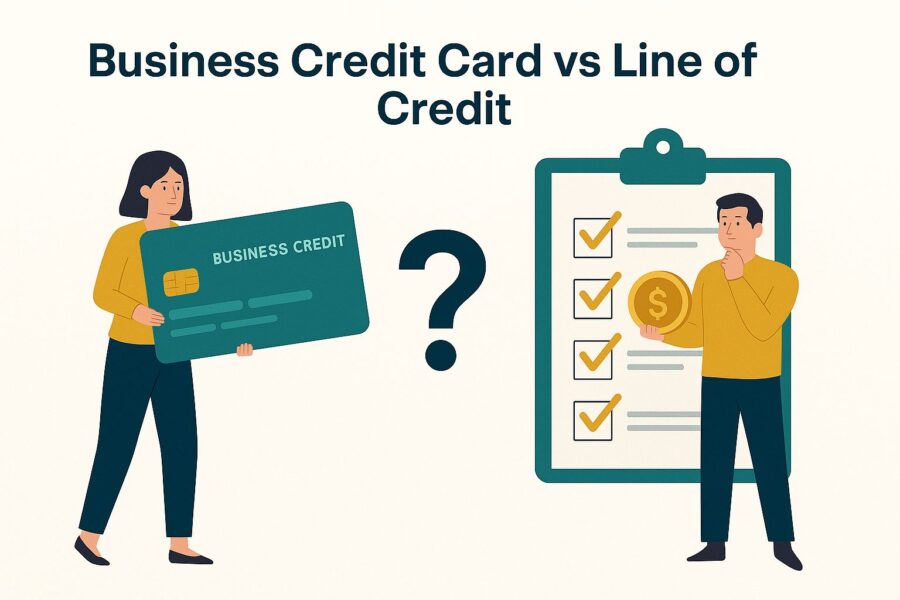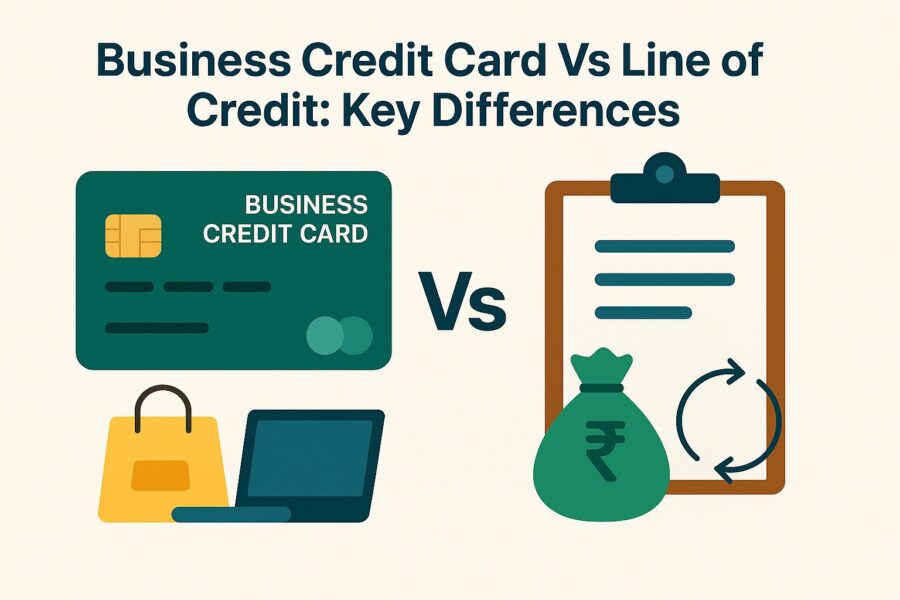Business Credit Card Vs Line of Credit: A Complete Guide for Business Owners
- 17 Oct 25
- 7 mins

Business Credit Card Vs Line of Credit: A Complete Guide for Business Owners
- Business Credit Card Vs Line of Credit: Key Differences
- How Does a Business Credit Card Work?
- Types of Business Credit Card Fees
- 5 Pros of Business Credit Cards
- 5 Cons of Business Credit Cards
- How Does a Business Line of Credit Work?
- Types of Business Line of Credit Fees
- 5 Pros of Business LOCs
- 5 Cons of Business LOCs
- Business Credit Card Vs Line of Credit: Which Is Better?
- Conclusion
Key Takeaways
- A business credit card is best for digital and daily expenses like travel, utilities, and online purchases, while a line of credit supports large transactions such as supplier or inventory payments.
- Business credit cards generally have lower limits (₹50,000–₹25 lakh), whereas lines of credit can extend to several crores based on the company’s credit profile.
- Credit cards charge interest after the grace period, while lines of credit only charge interest on the amount withdrawn, making them more flexible for repayment.
- Business credit cards are often unsecured and easier to obtain with minimal documentation, while lines of credit may require collateral or strong financial statements.
- Choose a business credit card for everyday operational payments and rewards, but opt for a line of credit when you need higher liquidity or to bridge cash flow gaps.
Managing business expenses often requires flexible financing. Over 65% of small and medium-sized enterprises in India rely on short-term credit facilities to maintain smooth operations. Two of the most popular tools are business credit cards and lines of credit. Each tool offers distinct benefits.
For example, a business may pay supplier bills of ₹3 lakh using a credit card with a ₹1 lakh limit and cover the remaining ₹2 lakh through a line of credit. Let us explore this guide to understand the differences between a business credit card vs line of credit, their fees, eligibility factors, and more.
Business Credit Card Vs Line of Credit: Key Differences

Choosing between a business credit card vs line of credit is not just about comparing fees and limits. This is mostly about matching the tool to your type of expense. Let us look at the table to understand the difference in detail.
| Parameters | Business Credit Card | Line of Credit |
| Suitability | For everyday digital expenses, vendor payments, travel, and SaaS subscriptions | Bulk purchases, inventory, supplier payments, emergency cash flow |
| Security | Mostly unsecured, some require personal or business guarantees | Can be secured (assets/collateral) or unsecured; unsecured is popular via lending fintechs |
| Period Availability | As long as the business needs | Specific draw period |
| Accessibility | Card, mobile wallet, UPI integration | Online platforms, apps, cards, cheques; instant draw via neobanks/fintechs |
| Credit Limit | Variable; however, lower than the line of credit | Variable, however, the full amount might not be approved |
How Does a Business Credit Card Work?
A business credit card functions in a way similar to personal credit cards. However, these are specially designed for small business owners, who can use these cards for cash advances, purchases and balance transfer.
Business credit cards can be secured or unsecured based on the issuer’s criteria. These credit cards have a fixed limit which users can use for spending.
Moreover, business owners need to pay a minimum amount on the outstanding balance. The used amount attracts a financing fee. The card issuer determines this fee and the minimum amount.
For instance, if the outstanding balance for a billing cycle is ₹10,000 for a cardholder, the minimum amount might be approximately ₹1,000. Notably, the business credit card account remains active as long as the cardholder wants.
💡Pay your credit card bills in an easy and secured way and experience smooth transactions with the PICE App.
Types of Business Credit Card Fees
| Type of Fee | Applicability |
| Annual Fee | Might or might not have an annual fee; the annual fee varies based on the issuer and card type |
| Interest Rates | Interest applies to the unpaid outstanding balance after the interest-free period (after the bill due date) |
| Late Fee | Varies based on the issuer |
| Over-limit Fee | Applicable if you exceed your credit card limit |
| Cash Advance Fee | Applies if you withdraw cash using your business credit card |
5 Pros of Business Credit Cards
- Easy credit approval with less documentation.
- Gives rewards, cashback, and travel points on spending.
- Establishes business credit history for future funding.
- Provides tracking of expenses and detailed monthly statements.
- Usually offers interest-free credit periods (also known as grace periods).
5 Cons of Business Credit Cards
- Increased interest charges if the balances are not paid on time.
- Lower credit limits compared to other financing options.
- Annual charges and hidden fees can mount.
- Overuse can damage a credit score and repayment ability.
- Limited appropriateness for big or ongoing business expenses.
How Does a Business Line of Credit Work?

Banks and financial institutions allow borrowers to borrow money up to a pre-approved limit, typically in the form of a line of credit (LOC), if a business requires cash flow or working capital. It can be unsecured or secured by business assets. Usually, banks set a specific tenure during which borrowers can use funds from a LOC.
Notably, the borrowed amount attracts a financing fee. However, borrowers can use the fund using cards, a cheque or a dedicated mobile app. Based on the business's credit history and financial health, banks determine the credit limit of a LOC.
The lender sets the minimum monthly payment and the due date. In case any amount is outstanding for repayment after the draw period, the lender sets instalments for a specific tenure.
Types of Business Line of Credit Fees
| Type of Fee | Applicability |
| Origination Fees | A processing fee applies at the time of application. |
| Draw Fee | Charged each time you withdraw funds |
| Annual Fee | Applicable each year |
| Interest Rates | Variable with no interest-free period |
| Late Fee | Variable based on the lender’s terms and conditions |
5 Pros of Business LOCs
- Flexible availability of funds as required up to the approved amount.
- Generally, lower interest rates compared to credit cards.
- Pay interest only on the borrowed amount actually used.
- Appropriate for meeting bigger or seasonal cash-flow shortfalls.
- It may be secured or unsecured, depending on the business profile.
5 Cons of Business LOCs
- Will need significant financial documentation for approval.
- Interest rates may be variable and difficult to predict.
- Can be secured by collateral or personal guarantees.
- Setup and maintenance fees can add to the overall cost.
- Risk of over-borrowing if mishandled.
Business Credit Card Vs Line of Credit: Which Is Better?
As a business owner, you can take both a business credit card and a line of credit. However, before applying, consider the type of payment, the repayment tenure, and the funds or expenses you need to cover.
Although the limit of a line of credit varies among lenders, a line of credit mostly offers a higher credit limit compared to a business credit card. If you need a higher credit limit, you can consider a line of credit.
However, if you have business expenses that do not need cash expenditure, you can use your business credit card. For instance, if you have to pay ₹10,000 for hotel rooms for multiple employees and your credit card limit is ₹1 lakh, you can use your credit card without any issues.
Conclusion
If you are in a dilemma between a business credit card vs line of credit, you can easily resolve it by considering the expenses that you need to cover. In case you have fees that cannot be paid in cash, you can choose a business credit card.
Alternatively, if you need cash payments and have higher expenses, you can choose a line of credit. Ensure you repay both your outstanding credit card amount and the money borrowed with a line of credit to establish a good credit history for your business.
 By
By 

















